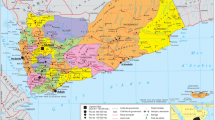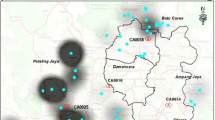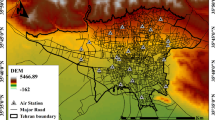Abstract
Air pollution poses an urgent challenge to public health and ecosystems, particularly in rapidly urbanizing regions. Despite the severity of this issue, there is a lack of robust analytical frameworks capable of identifying key variables and their spatial effects across landscapes. Our study directly addresses this void by applying an innovative supervised clustering approach to air quality data in Ho Chi Minh City (HCMC), Vietnam—a rapidly growing urban area grappling with escalating pollution levels. The analytical model employs Shapley Additive exPlanations (SHAP) to interpret feature importance within tree-based machine learning models, supplemented by the Unified Manifold Approximation and Projection (UMAP) technique to explore intersections between affected areas. We utilize a feature set from Rakholia et al. (2023) as input variables for each target time series, with a focus on answering key questions: What pollutants exert the most influence at different times of day? Which areas of the city are most affected? And can this method effectively pinpoint intersections of pollutant effects? Our results reveal morning traffic congestion predominantly elevates levels of Nitrogen Dioxide (NO2), Humidity, and Carbon Monoxide (CO), while afternoon emissions are significantly impacted by Sulfur Dioxide (SO2), CO, and Ozone (O3) due to solar radiation and industrial activities. Through this research, we expect to contribute to the ongoing discourse on urban air pollution management, highlighting the potential of artificial intelligence-driven tools in environmental research and policy-making.
Access provided by Autonomous University of Puebla. Download conference paper PDF
Similar content being viewed by others
Keywords
1 Introduction
Air quality is critical for human health and the preservation of the environment’s ecology. However, air pollution has become a major concern in many nations, bringing serious health hazards such as a rise in the incidence of heart disease, asthma, and lung cancer [1]. Air pollution also contributes to environmental issues such as global warming, acid rain, and depletion of the ozone layer. Rapid urbanization, uncontrolled transportation, and poorly regulated industrial environments all contribute to the issue. According to the World Health Organization (WHO), 9 out of 10 individuals live in areas where air pollution exceeds WHO limits [2]. According to studies, outdoor air pollution, mostly caused by Particulate Matter (PM2.5), causes millions of premature deaths per year globally [3].
With approximately 60,000 fatalities per year attributable to air pollution-related disorders, Ho Chi Minh City (HCMC) in Vietnam has a significant air pollution crisis. As the city’s economy and people have grown, so too has the harm to their health posed by the growing PM2.5 levels in the metropolis. By 2030, it is expected that PM2.5 levels in HCMC and other Vietnamese cities would have increased by 30% [4].
The levels of air pollutants, such as Nitrogen Dioxide (NO2), Ozone (O3), Sulfur Dioxide (SO2), and Carbon Monoxide (CO), in the city exceed the WHO threshold limits, posing serious risks to human health and the environment [5]. The non-linearity and time-varying nature of the data, as well as the complex interplay between air contaminants and meteorological conditions, provide the greatest challenge to accurate air pollution forecasting [6]. Artificial intelligence (AI)-based PM2.5 models have demonstrated better performance in dealing with non-linearity and time-varying data [7, 8].
This paper presents a supervised clustering approach based on Shapley Additive exPlanations (SHAP) values to investigate the impact of different air pollution factors, using a publicly accessible outdoor air quality dataset in HCMC. To better understand the causes of air pollution in specific areas, we employ this methodology to go deeper than simple statistical analyses of air contaminants. The main objectives of this study are to (1) identify air pollutant factors and their combinations that are likely to increase at specific time points, (2) identify affected stations or regions of the city, (3) determine the impact of increased pollutant levels on the other areas, and (4) determine the feasibility of using supervised clustering based on SHAP values to identify intersections between affected stations in the city.
2 Related Work
2.1 Application of AI in Forecasting Air Pollutants
There has been a growing trend in employing AI-based models for predicting air quality. Their ability to model non-linear associations and handle large-scale datasets makes them superior for air pollution prediction. Several AI-based models that have been used in this context include Random Forest [9], XGBoost [10], Neural networks [11], and Hybrid and Multi-output models [7, 8].
2.2 Interpreting Models with XAI – SHAP Approach in Environmental Research
The concept of eXplainable AI (XAI) has gained significant traction in recent AI research. The primary objective of XAI is to enhance the transparency and interpretability of complex AI models. One such method is the SHAP approach, which provides a cooperative game theory framework to explain the output of any machine learning model [12]. SHAP values has been effectively applied to diverse environmental research for its capacity to understand complex variable interactions, enhancing model interpretability [13,14,15]. Specific studies include its integration with machine learning for seasonal PM2.5 projections in Beijing [13], air pollution predictions [14], and highlighting critical factors in estimating NO2 concentrations [15]. Across these applications, the inclusion of SHAP has consistently improved the transparency, interpretability, and predictive power of the respective environmental models.
3 Investigating Air Pollution Dynamics Using XAI-SHAP Clustering
3.1 Dataset and Experimental Settings
For this study, we adopt the HealthyAir dataset [16], a database of environmental air quality measurements that is freely available to the public, for our evaluation. This public database comprises 52,549 records of air quality measurements compiled by the Air Quality Monitoring Network in HCMC. These records, which span February 2021 to June 2022, were collected from six air monitoring stations distributed across diverse urban locales including residential neighborhoods, commercial zones, and densely populated areas.
The dataset captures two weather conditions—Temperature (°C) and Humidity (%)—and hourly pollutant concentrations—PM2.5, Total Suspended Particles (TSP), SO2, O3, NO2, and CO—measured in µg/m3. Our research considers data from the following monitoring stations in HCMC:
-
Urban background: Vietnam National University, HCMC (10.86994333, 106.7960143).
-
Residential: 49 Thanh Da Street, Binh Thanh District, HCMC (10.81584553, 106.7174282).
-
Traffic: 268 Nguyen Dinh Chieu Street, District 3, HCMC (10.77636612, 106.6878094).
-
Traffic + Residential: MM18 Truong Son Street, District 10, HCMC (10.78047163, 106.6594579).
These records underwent various preprocessing stages, including unit conversions, data transformations, and missing value treatments as per established literature [7, 8]. Input variables for each potential air pollutant combination as per Rakholia et al. [8] were sorted for selected time points based on typical patterns of human activity and traffic congestion in HCMC.
3.2 Constructing and Assessing ML Classification Models
We employed a range of cutting-edge tree-based ML methods, such as decision tree, random forest, gradient-boosting decision tree (GBDT), histogram-based gradient-boosting classification tree (HistGBDT), and light gradient-boosting machine (LightGBM, version 3.3.3). The dataset was divided into training and testing sets, and classifiers were trained and tested under different configurations. The performance of ML classifiers was evaluated using metrics like accuracy, precision, recall, and F1-score. All experiments were run on a GPU server with specific specifications.
3.3 SHAP-Based Dimensionality Reduction
In order to highlight the value of dimensionality reduction using SHAP values, we performed supervised clustering using average SHAP values as per the feature set proposed by Rakholia et al. [8] for each target time series in the dataset. Tree-based ML models were used to categorize target areas, excluding PM2.5 and TSP from the analysis. Additionally, the UMAP (Uniform Manifold Approximation and Projection) technique was employed to depict intersections between affected regions, providing a two-dimensional visual of high-dimensional data.
4 Study Findings and Insights
4.1 Hourly Variations in Air Pollutant Concentrations Across Monitoring Stations
We leveraged a suite of tree-based machine learning models to classify monitoring stations in HCMC into Urban background, Residential, Traffic, and Traffic plus Residential, based on NO2 air pollution level at various time intervals (Table 1). We observe that certain models routinely achieve higher performance across different time intervals. LightGBM, HistGBDT and Random Forest classifiers, for example, perform well across all metrics, especially recall, which is essential for reducing false negatives, while the Decision Tree model results in relatively lower scores. We can see how well all tree-based ML models perform at 9 AM and 5 PM. The Random Forest model performs the best at both 9 AM and 5 PM time points, with the highest accuracy, precision, recall, and F1-scores. Overall, the performance of all models is higher at 5 PM than at 9 AM, except for the HistGBDT model. Notably, the models’ performances underscored the influence of time and pollutant type on air pollutant concentration classification (Table 1).
4.2 Feasibility of Supervised Clustering Using SHAP Values
In our experiments, we were unable to distinguish stations from the air quality dataset at specific targeted time points when projected in two-dimensional space using UMAP (Fig. 1A; top left panel). To enhance station characterization from a range of air contaminants, we used a supervised clustering approach, converting raw data into SHAP values from an optimal tree-based trained ML model. We utilized the XAI- SHAP approach to offer insights into the processes behind the contribution of these factors to certain area assignments and examined the intersections between affected areas using the UMAP technique (Fig. 1B; right panel). Based on our analysis of the spatial and temporal dynamics of air pollution variables in HCMC, we have discovered that using SHAP embedding plots for interference mapping between monitoring stations can significantly improve the precision in categorizing the city’s neighborhoods. This also enables us to examine the impact of increased pollution levels in different regions on the primary categorization area.
UMAP visualization and SHAP-based supervised clustering for air quality monitoring stations for O3 air pollution levels at the 7 AM targeted time point. (A) The unsupervised UMAP projection of stations from the air quality dataset, highlighting the difficulty in distinguishing stations based on raw data alone. (B) Supervised clustering approach using SHAP values derived from tree-based trained ML models, demonstrating improved station characterization based on air pollutant sets. This visualization provides insights into the processes under-lying the contributions of specific variables to station assignments and reveals the intersections between affected areas.
5 Conclusion
In this work, we present a supervised clustering approach based on average Shapley Additive exPlanations (SHAP) values to investigate the impact of various air pollutant factors in Ho Chi Minh City (HCMC), Vietnam. By employing a feature set from Rakholia et al. (2023) in tree-based machine learning models and using the eXplainable artificial intelligence (XAI)-SHAP approach along with the Uniform Manifold Approximation and Projection (UMAP) technique, we can gain a deeper understanding of the influence of various factors and the interplay between impacted regions. The benefits of our proposed methodology are as follows:
-
Enhanced classification performance: Improved accuracy and precision in categorizing air pollution levels.
-
Interpretability: The use of SHAP values allows for better understanding and ex-planation of model predictions.
-
Visualization: The combination of SHAP and UMAP techniques provides an effective visualization of the relationships between variables and their impacts on air quality.
-
Adaptability: The methodology can be easily adapted to other datasets, locations, and environmental challenges.
References
Mills, N.L., Donaldson, K., Hadoke, P.W., Boon, N.A., MacNee, W., Cassee, F.R., et al.: Adverse cardiovascular effects of air pollution. Nat. Clin. Pract. Cardiovasc. Med. 6(1), 36–44 (2009)
Perez Velasco, R., Jarosinska, D.: Update of the WHO global air quality guidelines: systematic reviews - An introduction. Environ. Int. 170, 107556 (2022)
Lelieveld, J., Evans, J.S., Fnais, M., Giannadaki, D., Pozzer, A.: The contribution of outdoor air pollution sources to premature mortality on a global scale. Nature 525(7569), 367–371 (2015)
Amann, M., Klimont, Z., An Ha, T., Rafaj, P., Kiesewetter, G., Gomez Sanabria, A., et al.: Future air quality in Ha Noi and Northern Vietnam. IIASA Research Report. Laxenburg, Austria (2019)
Fan, P., Ouyang, Z., Nguyen, D.D., Nguyen, T.T.H., Park, H., Chen, J.: Urbanization, economic development, environmental and social changes in transitional economies: Vietnam after Doimoi. Landsc. Urban Plan. 187, 145–155 (2019)
Xu, Z., Dun, M., Wu, L.: Prediction of air quality based on hybrid grey double exponential smoothing model. Complexity 2020, 1–13 (2020)
Rakholia, R., Le, Q., Vu, K., Ho, B.Q., Carbajo, R.S.: AI-based air quality PM2.5 forecasting models for developing countries: a case study of Ho Chi Minh City, Vietnam. Urban Climate 46, 101315 (2022)
Rakholia, R., Le, Q., Ho, B.Q., Vu, K., Carbajo, R.S.: Multi-output machine learning model for regional air pollution forecasting in Ho Chi Minh City, Vietnam. Environ. Int. 173, 107848 (2023)
Joharestani, M.Z., Cao, C., Ni, X., Bashir, B., Talebiesfandarani, S.: PM2.5 prediction based on random forest, XGBoost, and deep learning using multisource remote sensing data. Atmosphere 10(7), 373 (2019)
Zhong, J., Zhang, X., Gui, K., Wang, Y., Che, H., Shen, X., et al.: Robust prediction of hourly PM2.5 from meteorological data using LightGBM. Nation. Sci. Rev. 8(10), nwaa307 (2021)
Li, T., Hua, M., Wu, X.: A hybrid CNN-LSTM model for forecasting particulate matter (PM2.5). IEEE Access 8, 26933–26940 (2020)
Lundberg, S.M., Lee, S.I.: A unified approach to interpreting model predictions. In: Advances in Neural Information Processing Systems 30 (2017)
Wu, Y., Lin, S., Shi, K., Ye, Z., Fang, Y.: Seasonal prediction of daily PM2.5 concentrations with interpretable machine learning: a case study of Beijing, China. Environ. Sci. Pollut. Res. 29(30), 45821–45836 (2022)
Gu, Y., Li, B., Meng, Q.: Hybrid interpretable predictive machine learning model for air pollution prediction. Neurocomputing 468, 123–136 (2022)
García, M.V., Aznarte, J.L.: Shapley additive explanations for NO2 forecasting. Eco. Inform. 56, 101039 (2020)
Rakholia, R., Le, Q., Vu, K.H.N., Ho, B.Q., Carbajo, R.S.: Outdoor air quality data for spatiotemporal analysis and air quality modelling in Ho Chi Minh City, Vietnam: a part of HealthyAir Project. Data Brief 46, 108774 (2023)
Acknowledgements
This work is part of the MSCA Career-FIT PLUS fellowship, funded by the Enterprise Ireland and the European Commission (Fellowship Ref. Number: MF20200157).
Author information
Authors and Affiliations
Corresponding author
Editor information
Editors and Affiliations
Rights and permissions
Copyright information
© 2024 The Author(s), under exclusive license to Springer Nature Switzerland AG
About this paper
Cite this paper
Goktas, P., Rakholia, R., Carbajo, R.S. (2024). Investigating Air Pollution Dynamics in Ho Chi Minh City: A Spatiotemporal Study Leveraging XAI-SHAP Clustering Methodology. In: Nowaczyk, S., et al. Artificial Intelligence. ECAI 2023 International Workshops. ECAI 2023. Communications in Computer and Information Science, vol 1948. Springer, Cham. https://doi.org/10.1007/978-3-031-50485-3_20
Download citation
DOI: https://doi.org/10.1007/978-3-031-50485-3_20
Published:
Publisher Name: Springer, Cham
Print ISBN: 978-3-031-50484-6
Online ISBN: 978-3-031-50485-3
eBook Packages: Computer ScienceComputer Science (R0)





